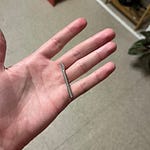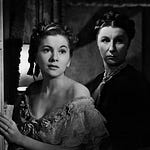Frankie and I met up at Metropolitan. For a few hours, we sat at a corner table on the back patio, smoking, drinking, and wiggling our fingers at trans people we recognized from the internet. After dishing about our jobs, our girlfriends, and Gretchen Felker-Martin’s banger episode on the Gender Reveal podcast our conversation landed on people who are stuck—those pitiable souls who can’t admit they’re queer or who won’t transition, and maybe never will.
Why do grownup transsexuals like Frankie and I have any interest in stuck people? Because we’ve been them ourselves, to varying degrees, and will never outrun the risk of becoming them again. Because, deep lez though we are, she and I know people like this, and as long as heterosexuality exists we always will. For as much sturm und drang there seems to be around community—what it means, what it does, who’s in, who’s out—the construct is nothing if not dynamic. Community is something you do, not something you have or are in. As such, stuck people meander in and out of our lives as friends, lovers, coworkers, acquaintances, nemeses. Are the stuck people here with us in the room right now? Often! Even if they do tend to have one foot out the door.
You can’t talk about closet-cases without talking about chasers, too. Many people, and not just the straight ones, are fond of accusing our biggest fans (as well as our fiercest enemies) of secretly being among our ranks, which is facile and stupid and transphobic, actually. But that doesn’t mean that cis fascination with us—of both the positive and negative tenors—can’t be located in their relationships with their own genders. As trans people, we are symbol and proof of the world’s unraveling, which sounds pretty dramatic until you’ve been on this side of things. In our realness, trans people expose systemic artifice so foundational that departing from it in thought or deed can literally drive you crazy. Confronting that is terrifying, especially if you’re cis, since in that case you actually have something to lose if the whole thing were to ever come tumbling down. This means, incidentally, that cis fascination with us is also about power. But when is gender not about that, too?
Are all chasers stuck? No, I don’t think so, though of course many of them are. If you’re trans, and particularly if you’re transsexual, then you’ve surely encountered someone who loves you because they can’t see you—only themself, or a version of themself that they wish existed. Or perhaps they see you so much they can’t see themself at all. However you slice it, you’re not having a person-to-person interaction with them, or only rarely. How can you, if not everyone in the room is a person?
Frankie and I can happily bitch about chasers at length, but for my money there’s a time and a place for them, as long as you know what you’re doing. It can be fun or sexy to be worshipped, especially when the reason for that worship is why the rest of the world reviles you. If everyone is going to be obsessed with us, at least the chaser variation comes with perks.
My advice for indulging chasers is this: think of your time with them as a vacation from being a person, rather than an exiling from humanity. Just don’t forget that vacations, by definition, are temporary.
In part one of this series about gendered social contagion, I said that I wanted to write about “the cis people who saw my transness” before I knew of it myself. The chaser can’t see anything but my transness; in this way, they’re indistinguishable from almost all other cis people.
Who was my first chaser? I asked myself. Not gay men on hookup apps. Not the cis femmes who talk about trans mascs as if we’re pets or men, but can’t find it in themselves to date anyone else. Not the dykes who asked me not to transition, but watched trans porn exclusively. Not the straight men with force fem fantasies that could only come to life in the dark. Not the straight women who felt I should be grateful to fuck them, and met any disinterest on my part with indignation and shock.
If we’re defining the chaser as someone who calls their obsession with your gender love, then my first chasers were probably my parents. Which is to say that the people most invested in making sure I wasn’t trans played a role in bringing it to pass.
In liberal terms, the rights of trans people are often framed along the lines of “expression.” It’s inhumane not to permit us to be authentic to ourselves, goes the logic; when given the opportunity to do so, we are bravely living our truths. However well-meant, the closet understood as facade positions us, a priori, as liars. As I wrote in another post, “If our genders are produced, that means that the concealment, deception, and revelation of deviant genders is also produced.”
I don’t think the closet metaphor goes far enough when understood in this way. For me, closeting was not like wearing a mask or a costume, allowing for at least some part of “the real me” into the daylight. It was like being dead. Gender organizes how we share information about ourselves—that is, it’s how we communicate. Our genders inform and shape how we are polite and rude, gentle and violent; how we convey want, need, desire, and interest. Like age, race, class—a whole mess of things—gender (like community) is something you do. Even agender people must interact with people with genders, in cultures and milieus organized around normative gender, and are beholden, on some level, to gendered interaction, particularly in how others understand them. Without your gender (or lack thereof), as you understand it, you are nothing. Maybe, like me, you’re spiritually dead. Maybe, like trans people without the luck and safety I’ve had, you’re literally dead.
So. Say your gender isn’t safe. Say your only alternative, for the moment, anyway, is death. The thing about chasers is that they, like transphobes, see dead people. As I walked home, thinking over my conversation with Frankie, I wondered what would have happened to me if the chasers had never found me, over and over again. They’re cogs in the system that produces deviant genders, sure. But they’re the bloodhounds that sniff us out, too. Maybe a better comparison would be one of those fish that live on the shark’s pearlescent underside, feeding with the focus only a parasite can offer.
Find me on Twitter. Get my second novel, X, right here.
This week, Astra published my piece on Nitehawk’s Pride screening of BloodSisters: Leather, Dykes & Sadomasochism (1995), feat. my leather associate, Daemonumx, if you’d like to give it a read.
Subscribe to support GOOD ADVICE/BAD GAY, DAVID’s advice series from an anonymous gay therapist who’s not afraid to hurt your feelings with the truth. (Sample an unlocked post for a taste of what you’re missing.) 100% of funds go to support a rotating selection of mutual aid and reparations projects.
Want advice? Email badgayadvice@gmail.com for a free 3-month subscription.














